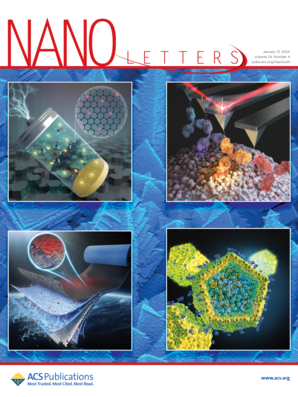Quantum-Sized Sb@Au Schottky Heterostructure for Sensitized Radioimmunotherapy
IF 9.6
1区 材料科学
Q1 CHEMISTRY, MULTIDISCIPLINARY
引用次数: 0
Abstract
Radiodynamic therapy (RDT) holds great potential for overcoming radioresistance and enhancing tumor immunogenicity. However, its efficacy is hindered by limited reactive oxygen species (ROS) generation due to insufficient carrier generation and transfer, which often results in tumor metastasis. Here, we report quantum-sized and narrow-bandgap Sb@Au Schottky heterostructures, namely, Sb@Au nanodots (Sb@Au NDs), to improve ROS generation for sensitizing RDT and inhibiting tumor metastasis. Experimental results and density functional theory calculations show that Sb@Au NDs give narrow bandgap and high Schottky potential barrier for promoting carrier generation and separation under X-ray irradiation, and present rich active sites for improving catalytic performance, leading to abundant ROS generation and significantly amplifying intracellular oxidative stress to enhance RDT. Sb@Au ND-sensitized RDT greatly induces immunogenic cell death and thus promotes CD8+ T cell-mediated systemic immunity, ultimately suppressing tumor metastasis. Our finding highlights the potential of narrow-bandgap Sb@Au NDs as an effective sensitizer for radioimmunotherapy.

致敏放射免疫治疗的量子级Sb@Au肖特基异质结构
放射动力治疗(RDT)在克服放射耐药和增强肿瘤免疫原性方面具有巨大的潜力。然而,由于载体生成和转移不足,活性氧(ROS)的生成有限,往往导致肿瘤转移,影响了其疗效。在这里,我们报道了量子大小和窄带隙Sb@Au肖特基异质结构,即Sb@Au纳米点(Sb@Au NDs),以改善ROS的产生,从而使RDT增敏并抑制肿瘤转移。实验结果和密度泛函理论计算表明,Sb@Au NDs在x射线照射下具有窄带隙和高肖特基势垒,促进载流子生成和分离,并具有丰富的活性位点,可提高催化性能,导致大量ROS生成,显著放大细胞内氧化应激,增强RDT。Sb@Au nd致敏的RDT极大地诱导免疫原性细胞死亡,从而促进CD8+ T细胞介导的全身免疫,最终抑制肿瘤转移。我们的发现突出了窄带隙Sb@Au NDs作为放射免疫治疗的有效增敏剂的潜力。
本文章由计算机程序翻译,如有差异,请以英文原文为准。
求助全文
约1分钟内获得全文
求助全文
来源期刊

Nano Letters
工程技术-材料科学:综合
CiteScore
16.80
自引率
2.80%
发文量
1182
审稿时长
1.4 months
期刊介绍:
Nano Letters serves as a dynamic platform for promptly disseminating original results in fundamental, applied, and emerging research across all facets of nanoscience and nanotechnology. A pivotal criterion for inclusion within Nano Letters is the convergence of at least two different areas or disciplines, ensuring a rich interdisciplinary scope. The journal is dedicated to fostering exploration in diverse areas, including:
- Experimental and theoretical findings on physical, chemical, and biological phenomena at the nanoscale
- Synthesis, characterization, and processing of organic, inorganic, polymer, and hybrid nanomaterials through physical, chemical, and biological methodologies
- Modeling and simulation of synthetic, assembly, and interaction processes
- Realization of integrated nanostructures and nano-engineered devices exhibiting advanced performance
- Applications of nanoscale materials in living and environmental systems
Nano Letters is committed to advancing and showcasing groundbreaking research that intersects various domains, fostering innovation and collaboration in the ever-evolving field of nanoscience and nanotechnology.
 求助内容:
求助内容: 应助结果提醒方式:
应助结果提醒方式:


